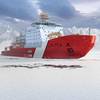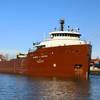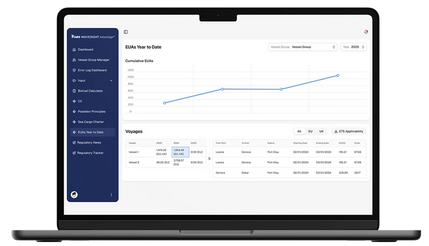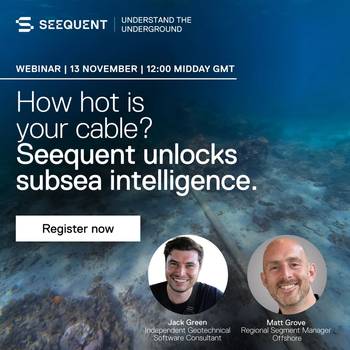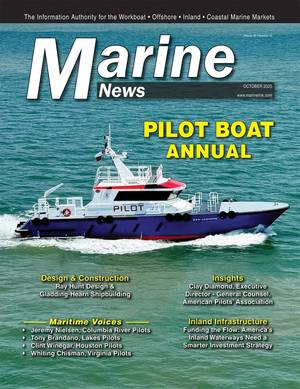How Life Extension and Conversion Redefines “Born Again” in U.S. Ship Repair
We are well into the discussions advising shipbuilders and operators how the U.S. will create a renaissance of the maritime industry. Federal Legislation, Executive Orders, and new foreign partnerships driving the promise of commercial competitiveness with the leading global shipbuilders. Most of the shipbuilding rhetoric indicates the domestic markets will be left to survive on their own. This despite the fact the domestic operators and builders have proven to be the strongest undercurrent to decisions and amendments on the legislation efforts.
It is year-end here at Maritime Reporter & Engineering News. With that gathering of actual shipbuilders and operators comes the end of the political storytelling and the announcements of who is building and who is not. In our opinion 2026 will fall into who is not as the geopolitical rhetoric continues. Unfortunately, the problem is not the builders, not the owners or managers and in some cases not the markets. It is just mass political confusion of what direction the industry is going to take and how we build a supply chain or manufacturing base to support and meet the White House goals. Life extension and conversion to existing tonnage in our repair yards can educate the political leaders on how to solve the problems.
Year End: The Storm Looms
Let’s concentrate on the home front and the domestic projects developing beyond the stories of new construction shipyards competing for Navy and USCG work now coupled with new foreign partners promising global competitiveness. We are still asking where is the support of our commercial fleet and most look to lucrative Navy contract.
Domestic trading opportunities are developing as historical clean and dirty petroleum products are slowly accompanied by chemical and gas. In the chemical markets few if any of the existing domestic barges are capable of transporting new bio fuels, chemicals and or base products. The Cargo Authority approvals can range between confirming proper cargo tank coatings, stainless steel cargo systems, cargo pump capability and IBC code requirements. Despite the now “one-year delay” in meeting the IMO MEPC net zero wish list, new cargoes will continue to develop.
Despite the MEPC vote to delay the position on carbon tax and emissions, the foreign tonnage entering the U.S coasts will require new bunkering sources to address alternative fuels. With that necessity, coastwise registered domestic vessels will need to distribute these cargoes from one U.S. port to another. With our lessons learned identifying the U.S. manufacturing base and supply chain is one of the lead problems with our shipbuilding growth, there are other commodities that will also increase in demand globally and can move to rebuild U.S. infrastructure and manufacturing.
Hopefully the geopolitical discussions in our government departments will wake up to the fact that Gaza needs to be rebuilt and at some point, Ukraine. With that wakeup call, new legislation to support the effort and demand U.S. material be required, can work towards agreements that these goods will be delivered to on new U.S. Flag tonnage. Not an absurd request considering the cost of military equipment and funding the U.S. has provided to both regions. Russia has a ghost fleet, with tariffs and taxes, the global trading patterns are changing and U.S. maritime needs to step to the front of the line with support of our Navy.
LNG has been addressed with capable bunkering tonnage provided. A move to Ammonia, Hydrogen, Methanol or the simplest of alternative fuels in the U.S. fleet has not. Make no mistake, there is no domestic customer base to build or charter new “Bluewater” ship tonnage at the current prices estimated to build that tonnage. The commercial trading markets can’t absorb both the construction Capex and the full crew compliment of US ship operation. To support our domestic markets, we turn to tug & barge in an attempt to solve both of those problems.
None of this should be a surprise.
 Image courtesy Amtech
Image courtesy Amtech
ATBs: The Future Domestic Coastwise Fleet
The purpose of the Articulated Tug & Barge design developed in 1950 and further advanced in the 1970’s and 1980’s was to provide additional operational performance beyond historic tug tow line. In 1981, the USCG recognizing the ATB safety advantages and created new regulatory amendments that affected crew size and inspection criteria.
Make no mistake, with new ship construction current price levels, the ATB is our future domestic coastwise fleet. The next steps should be the continued pursuit to elevate designs and work towards becoming more efficient in ATB construction. It is not only “Bluewater” costs that are rising. It is also “Brownwater”. And with that, we are seeing a transition period develop with projects addressing life extension and conversion of existing ATB tonnage while the cargo priorities shift from historical petroleum products to a new set of commodities in wet markets.
AMTECH developed an ATB life extension and conversion project in mid-2024 with Marathon Asset Management of New York and Gulf Marine Repair in Tampa, Florida. The business model included the purchase of an existing 155,000-barrel petroleum barge and Articulated Tug along with a design proposal to convert the vessel to trade soft chemicals. The selected tonnage was idle in layup and eighteen years of age when purchased. A 15-year life extension was targeted for the reconstruction.
The business model was developed based upon the purchase of existing tonnage and conversion compared to the estimated cost of new construction. Cost estimates were provided by several U.S. yards. The selection of life extension and conversion resulted in a greater than 60% reduction in the asset capital cost when delivered.
The project development took into account every shipbuilding issue debated in Washington, DC circles over the past 12 months and with that a “lessons learned” of what our actual “shipbuilding” problems are were well defined. It is an underdeveloped manufacturing base and a supply chain of near zero. We still need foreign support from our allies.
Three hundred and twenty tons of steel were renewed after extensive gauging and survey. All of the steel was renewed in a U.S. shipyard with U.S. labor. In the logistics category, the purchase and delivery of steel was identified as a major problem and most was delivered from foreign sources despite a request that no Chinese steel be supplied. A complete redesign of the cargo piping system was completed in 316 stainless steel. Stainless pipe, fittings and valves were near nonexistent in U.S. inventory. The supply chain delivery quotes in these categories were 18 to 30 weeks. If purchased foreign, extended delays exist to request of Imperial standards versus global metric.
Cargo tanks reconstruction was specifically targeted to support an investment with Advanced Polymer Marine Line tank coatings to allow the carriage of new cargoes. This is the first U.S tank barge project applied with Marine Line in the United States to support the commercial and trading applications. Anchor Sandblasting & Coating of Tampa agreed to take on the project and our Amtech South Korea teams provided previous coating experience from our new construction contracts in Hyundai. Anchor Sandblasting & Coating attended shipyards in Turkey to complete the training and take part in coating repairs during the attendance. The selection of Marine Line was an important part of the conversion. The polymer coating provides superior resistance to corrosion and wear, a faster cleaning surface and upgrades to cargo sequencing.
Our Korean teams could not obtain Visa(s) under current immigration issues in the U.S. If U.S shipbuilding is determined to partner and learn from the Far East global shipbuilding powerhouses – H1 Visa approval for professional engineers, trainers and educators is paramount for the advancement of new technologies applied in the Far East.
The project did not experience a lack of labor at Gulf Marine. When schedule advances were required, additional labor was made available. The quality of the work we inspected and approved in near every trade was well above satisfactory. The American shipyard worker can do the job and the Port of Tampa continues to be “shipbuilding” supportive.
Each piece of machinery on both tug and barge was dismantled, inspected and rebuilt and/or upgraded when the existing suppliers could not confirm spare part sustainability into the fifteen-year life extension. The media reports of labor issues have not taken into account the large number of small business repair shops completing overhauls, licensed by the major manufacturers and providing auxiliary equipment and manpower throughout the repair industry. This is the representation and value of the American entrepreneurial spirit and the support those of us on the deck plates are thankful for each day. The project is working through commissioning and will sea trial shortly prior to entering the market.
All of the efforts move towards rebuilding Maritime Superiority – global or domestic.











